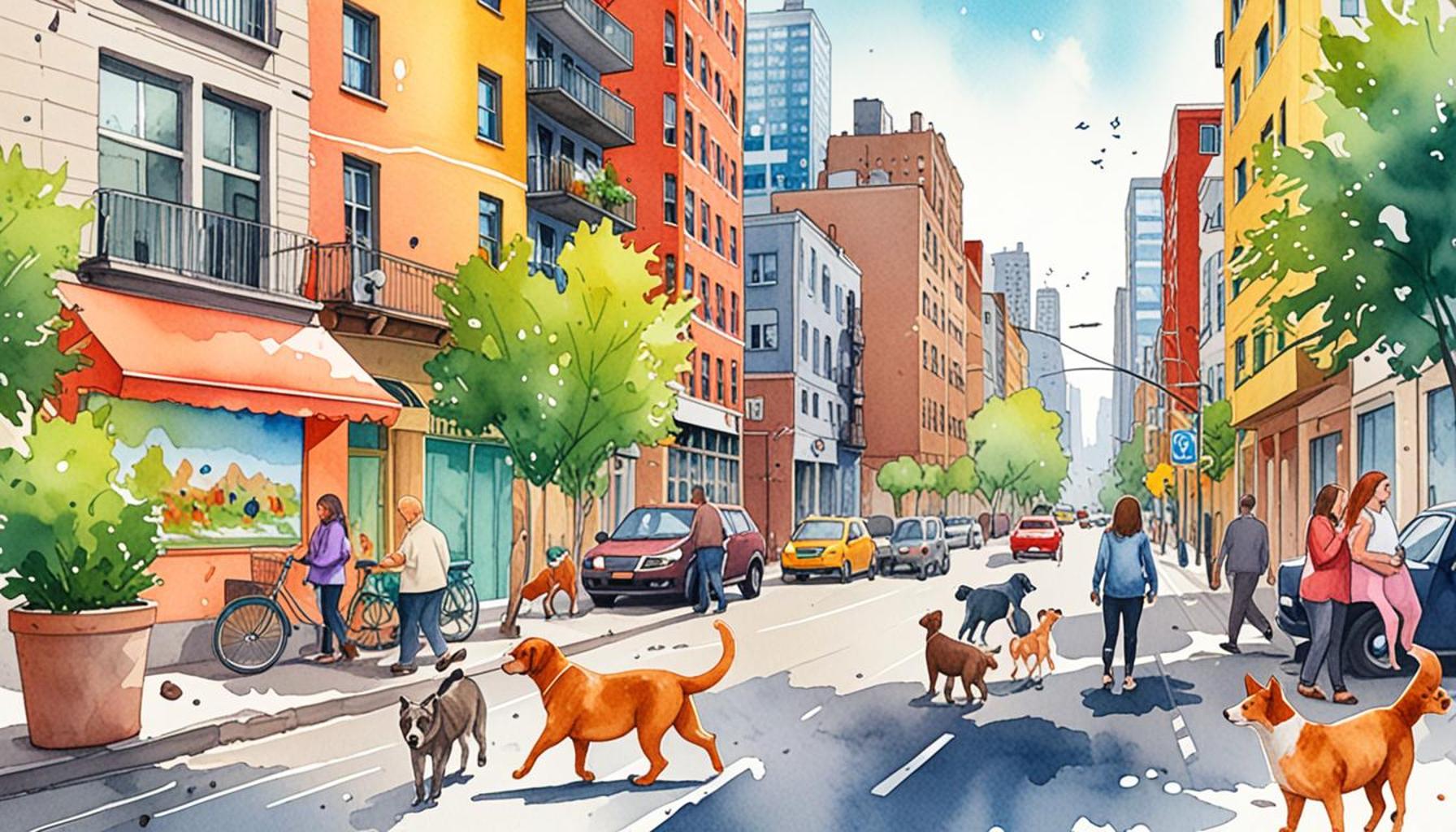The Challenges and Benefits of Integrating Companion Animals in Urban Environments

Understanding the Role of Companion Animals in Urban Environments
As urbanization continues its relentless pace, the presence of companion animals has begun to emerge as a pivotal aspect of city life. These animals—ranging from dogs and cats to birds and even reptiles—are not just pets; they serve as vital emotional anchors for many residents, providing comfort in an often chaotic urban landscape. Their influence extends beyond individual households, shaping community dynamics and contributing to wider social interactions.
However, the integration of pets into urban life is laden with both challenges and unique opportunities that require careful consideration.
Challenges Faced by Urban Pet Owners
One of the most pressing challenges that urban pet owners face is limited living space. In densely populated metropolitan areas, many residents live in apartments that may not be suitable for larger animals. For example, a Great Dane might find it challenging to thrive in a compact studio apartment where room to move is limited. Additionally, urban settings often lack sufficient access to green spaces, which are crucial for exercising dogs and allowing pets to experience the outdoors in a safe environment.
Moreover, the need for responsible pet ownership cannot be overstated. Civic issues such as noise pollution from barking dogs or the risk of pet waste on sidewalks can cause friction between pet owners and non-pet owners. Educating residents about leash laws, pet hygiene, and the importance of vaccination is vital for maintaining peace within communities.
Benefits of Urban Pet Ownership
Despite these challenges, the benefits of pet ownership in cities are substantial and multifaceted. First and foremost, companion animals contribute significantly to mental well-being. Numerous studies indicate that interaction with pets can lower stress levels, reduce anxiety, and even boost self-esteem. A short walk with a dog can serve as a mental health break from the hustle and bustle of daily life, providing a sense of purpose and routine.
Furthermore, pets naturally facilitate social interactions. Whether it’s striking up a conversation in a dog park or bonding with neighbors over shared pet-related interests, animals often act as social catalysts that foster community ties. Events such as local pet parades or dog training classes encourage residents to connect, building a sense of belonging that enhances the urban experience.
Finally, the rise of urban pet ownership has given birth to a flourishing market for local businesses focused on pet care, grooming, and specialized products. Pet-friendly cafes, boutiques, and even daycares have sprung up, creating jobs and economic opportunities while catering to the needs of pet owners.
In considering the role of companion animals in city life, it becomes clear that understanding these interconnected aspects is vital. As urban environments evolve, creative and practical solutions must be innovated to accommodate both pet owners and the larger community. In doing so, cities can retain their vibrancy while ensuring a harmonious coexistence with our cherished furry friends.
LEARN MORE: Click here to discover how pets can boost your mental health
Navigating Urban Pet Ownership
As urban centers continue to expand and modernize, the challenges of integrating companion animals into metropolitan lifestyles become increasingly evident. The dynamics of pet ownership in cities differ significantly from rural environments, where space is typically more abundant and community interactions evolve differently. Understanding these unique struggles is essential for fostering a harmonious coexistence between pets and urban residents.
One undeniable barrier for urban pet owners is the lack of affordable housing options that are pet-friendly. Many landlords impose strict pet policies, often requiring hefty deposits or prohibiting certain breeds altogether. This can limit housing options for pet owners, forcing them into either substandard living conditions or locations that may not afford them the quality of life they desire. The U.S. apartment market, particularly in cities like New York and San Francisco, is notorious for its stringent pet policies, which can displace pet owners into less desirable neighborhoods.
Furthermore, space constraints for exercising and caring for pets pose significant challenges. Without ample parks or green spaces, dog owners can struggle to provide their pets with adequate exercise. In cities like Los Angeles, where the sprawling urban layout is punctuated by busy streets, finding a safe area for pets to roam can often become a daily struggle. This lack of access can lead to behavioral problems and health issues in pets, exacerbating the stress experienced by their owners.
In addition to physical constraints, urban environments also amplify social challenges for pet owners. Conflicts arising from differences in lifestyle or perspectives on pet care can create rifts within communities. Issues such as noise complaints from barking dogs, pet waste left unattended, and safety concerns around aggressive animals can lead to tensions between pet owners and non-pet owners. According to a survey by the American Kennel Club, nearly 30% of pet owners reported conflicts with neighbors due to their pets, underscoring the necessity for responsible pet ownership education in urban areas.
Enhancing Cities Through Pet Integration
Despite these challenges, the presence of companion animals in urban settings yields notable benefits that contribute to the overall vibrancy of city life. The mental and emotional support that pets provide cannot be understated. As residents grapple with the stressors of urban living, pets serve as anchors that offer companionship while promoting emotional well-being. Studies have shown that owning a pet can result in lower instances of depression and anxiety among urban dwellers, reinforcing the importance of inclusivity for pet ownership in the city environment.
- Social Connectivity: Pets have an uncanny ability to break the ice, serving as conversation starters that lead to genuine connections between individuals. Whether through dog walking groups or community events, pet owners often find themselves networking in ways that enhance their social circles.
- Economic Contributions: The surge in urban pet ownership has catalyzed growth in local businesses including pet stores, grooming salons, and veterinary clinics. This rising demand fosters job creation and strengthens local economies, benefiting community members at large.
- Community Engagement: Local initiatives aimed at improving pet ownership conditions, such as accessible parks or pet-friendly public spaces, enhance community involvement and cohesion, as residents collaborate towards common goals.
The complexities of managing companion animals in bustling cityscapes highlight the need for proactive strategies that cater to both pet owners and the wider community. By examining the challenges and benefits of this integration, cities can promote environments where both humans and their beloved animals can thrive together.
The Challenges and Benefits of Integrating Companion Animals in Urban Environments
When we delve into the intricate relationship between companion animals and urban life, it’s crucial to explore the multifaceted challenges and advantages that arise. At first glance, we may think of the joys and companionship that pets bring; however, urban settings present unique obstacles that can complicate this relationship.To better understand these dynamics, consider the following table that highlights key insights into the challenges and benefits of integrating companion animals into our bustling cities:
| Challenges | Benefits |
|---|---|
| Limited Space | Enhanced Well-being: Studies show that owning pets can lead to reduced stress and improved mental health. |
| Noise and Disruption | Social Interaction: Pets can serve as social facilitators, helping owners connect with their community. |
| Health and Safety Risks | Physical Exercise: Walking a dog encourages regular activity, promoting physical health in urban residents. |
| Regulatory Restrictions | Emotional Support: Companion animals provide emotional stability, assisting in coping with urban life challenges. |
The integration of companion animals in urban settings brings forth a multitude of perspectives that must be examined thoroughly. From limited space for pets to navigate to the enhanced well-being they offer owners, understanding these dynamics is essential for both individuals and city planners alike. Urban environments, while bustling and lively, often pose challenges such as noise and disruption, yet they also provide remarkable social interactions through community engagement. Moreover, as urban dwellers face health and safety risks associated with pet ownership, it is critical to recognize the role of animals in promoting physical exercise and overall health for their owners. Understanding regulations can help alleviate concerns relating to regulatory restrictions, opening pathways for broader access and integration of pets into city life.Through deeper exploration of these themes, we can uncover innovative solutions and approaches to foster a balanced coexistence between urban living and companion animals, paving the way for a brighter, more inclusive future.
LEARN MORE: Click here for essential tips on keeping your pet healthy
The Role of Policy and Urban Planning
When it comes to integrating companion animals within urban environments, the role of policy and urban planning cannot be overlooked. Municipal regulations and zoning laws significantly shape the feasibility of pet ownership and the overall quality of life for both residents and their furry companions. Understanding and updating these policies is vital to embrace the full potential benefits of pet-friendly cities.
One area where policy plays a crucial role is in the establishment of dog parks. These specially designated areas are essential for alleviating the pressure of space constraints many urban pet owners face. However, urban planners often grapple with how to allocate land for such amenities, particularly in densely populated areas where space is at a premium. Cities like Chicago and Seattle have made significant strides by incorporating more green spaces and dog parks into their urban designs, serving as models for others hoping to foster better environments for pets and their owners.
Moreover, city ordinances can also dictate the safety measures around pet ownership. Regulations concerning leash laws, noise ordinances, and waste disposal can help mitigate conflicts between pet owners and non-pet owners. For instance, municipalities that prioritize responsible pet ownership by refining enforcement practices see a decrease in neighborhood tensions. According to the American Society for the Prevention of Cruelty to Animals (ASPCA), strengthening these policies can lead to increased community satisfaction, as pet owners feel empowered to engage responsibly with their environment.
Innovative Solutions and Community Involvement
In the face of challenges, urban centers are also witnessing innovative solutions aimed at enhancing the experience of pet ownership. Technology is increasingly playing a vital role in this revolution. Mobile applications that connect pet owners with local services—such as veterinary clinics, pet-friendly cafes, and parks—are becoming commonplace. This not only eases the logistics of having a pet in the city but also fosters a sense of community among residents.
Additionally, community engagement initiatives are bridging gaps between pet owners and other urban residents through education and outreach programs. Workshops on responsible pet ownership, community clean-up days, and local pet afternoons promote harmony among differing lifestyles. Such initiatives can lead to stronger community bonds, ensuring that every resident—pet owner or otherwise—has a stake in maintaining the urban environment.
Moreover, cities like Portland and Austin have embraced the idea of pet-friendly public transportation policies, making it easier for residents to travel with their animals. By allowing pets on public transport, these cities demonstrate a commitment to recognizing the integral role of companion animals in residents’ lives, enhancing their accessibility and inclusiveness.
- Policy Adaptation: Cities need to continually reassess their policies regarding pet ownership to adapt to the rising demand for pet-friendly environments.
- Green Infrastructure: Incorporating more green spaces and pet-friendly facilities is crucial in urban planning to ensure a balanced coexistence.
- Community Programs: Empowering local communities to participate in initiatives aimed at improving pet ownership conditions enhances urban life for everyone.
As the landscape of urban living evolves, so too must our perception and approach to integrating companion animals into city life. Comprehensive, adaptable policies combined with community-driven efforts will not only ease the challenges faced by pet owners but also enhance the overall societal benefits, creating a future where urban life and pets coexist harmoniously.
DISCOVER MORE: Click here for essential tips
Conclusion
As urban landscapes continue to evolve, the integration of companion animals into city life presents both challenges and remarkable benefits. Addressing space constraints, navigating municipal regulations, and fostering community involvement are essential steps for creating a harmonious urban environment where pets and humans can thrive together. By prioritizing pet-friendly policies, cities can enhance the quality of life for pet owners while mitigating conflicts with non-pet owners.
Innovative approaches, such as utilizing technology to connect pet owners with resources and making public transportation more inclusive of pets, demonstrate that thoughtful integration is not only possible but desirable. Additionally, community engagement initiatives can foster understanding and cooperation between pet owners and their neighbors, leading to stronger neighborhood bonds.
The undeniable mental and physical health benefits of pet ownership, including reduced stress and increased social interaction, highlight the importance of welcoming companion animals into urban settings. Cities that recognize and embrace this aspect of urban living will not only improve residents’ well-being but also position themselves as pioneering environments that reflect modern societal values. As we move forward, it is crucial that urban planners, policymakers, and community members work together to create inclusive spaces that allow for joyful coexistence with our furry friends, ensuring that both pets and their humans can enjoy the bustling life of the city.


